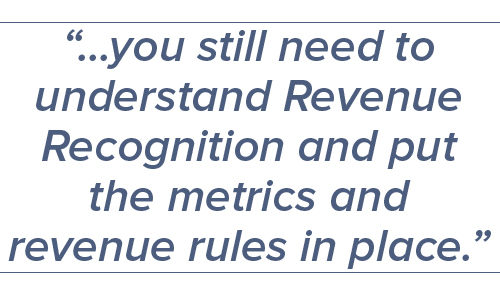[xyz-ips snippet=”insert-title”]
Forrester Research estimates a SaaS related expenditure level of over $150B by 2020. Many feel that this is a conservative estimate. There has been an explosive growth in SaaS companies in the US, garnering a Wild West sentiment. What are the challenges faced by these emerging growth SaaS companies? In this Blogpost, we will look briefly at three critical areas of focus.

SaaS Metrics – There are no standards for what SaaS metrics should be tracked. There is no central authoritative body establishing guidelines. Yet these metrics are the tools by which the company can see their growth, plan for the future and demonstrate competence to funding sources. SaaS metrics must be decided upon and understood early in the growth cycle. Is your team fluent in SaaS issues?
Revenue Recognition – Neglecting to institute an effective Revenue Recognition policy is extremely costly. Changing the internal practices is easy when done early, but is highly challenging to do later. There are third party software solutions available that can integrate with most accounting software, but you still need to understand Revenue Recognition, and put the metrics and revenue rules in place. Avoid the Revenue Recognition landmine by understanding the concept in advance. Does your company have a process and rules for Revenue Recognition?
SaaS Billing – Based upon the Revenue Recognition parameters a company installs, billing issues can also plague a SaaS company. Contracts are often inconsistent and may include pre-bill, annual, quarterly, monthly or other irregular periods. Do you have a system that frees you up for other pressing issues?
All of these factors impact the VC’s valuation of the SaaS company. What is the MRR (monthly recurring income) and LCV (Lifetime Customer Value)? These are examples of two critical questions that form the basis for valuation and get to the heart of unit economics. There are many other metrics that drive important decisions at the executive level. The data and the systems must be integrated.
Boards and management teams seeking to financially optimize their business should make certain that their CFOs be aware of and seek to incorporate these seven basic elements within a SaaS company…
- An ability to demonstrate the value of SaaS metrics and Revenue Recognition to Board Members, senior management, and other key stakeholders such as investors.
- Identification and implementation of the appropriate metrics for the client; one size does not fit all.
- Develop expert financial models. SaaS analytics are extrapolated to future periods for incorporation into long-term forecasts and investor presentations.
- Understanding the contractual language to streamline and optimize Revenue Recognition.
- Having a staff that can maintain the streamlined SaaS/GAAP processes.
- Implement cloud-based third-party tools, where applicable, to enhance reporting and data analytics.
- Provide integrity to the SaaS reporting and underlying financial results.
As we can see, SaaS companies face a different and more convoluted road to attaining a level of comfort in utilizing internal financial data as compared with more traditional business models.
Contributions by: Peter Kihara, Neil Goldenberg, and Andy Wiesenfeld – DecisionCFO, LLC.
Written by John Evans
Founder and CEO
Since founding DecisionCFO in 2008, John has advised 100+ early stage technology and healthcare company engagements whose combined financing and exit valuations are in excess of $1.5 billion. John is a former CFO of both publicly traded and venture-backed technology companies as well as a founder of Asia Media where he advised firms such as NBC Asia and Discovery Communications with their Asian expansion initiatives. John began his career at the Bank of New York Mellon.
Follow John on LinkedIn


